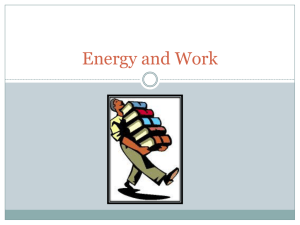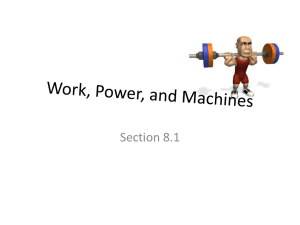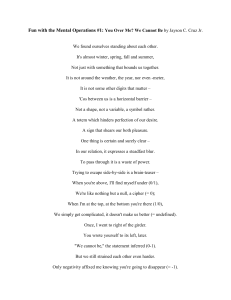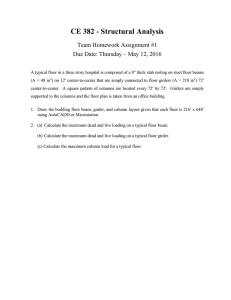Overhead Crane Structural Analysis: SS400 vs ST52-3
advertisement
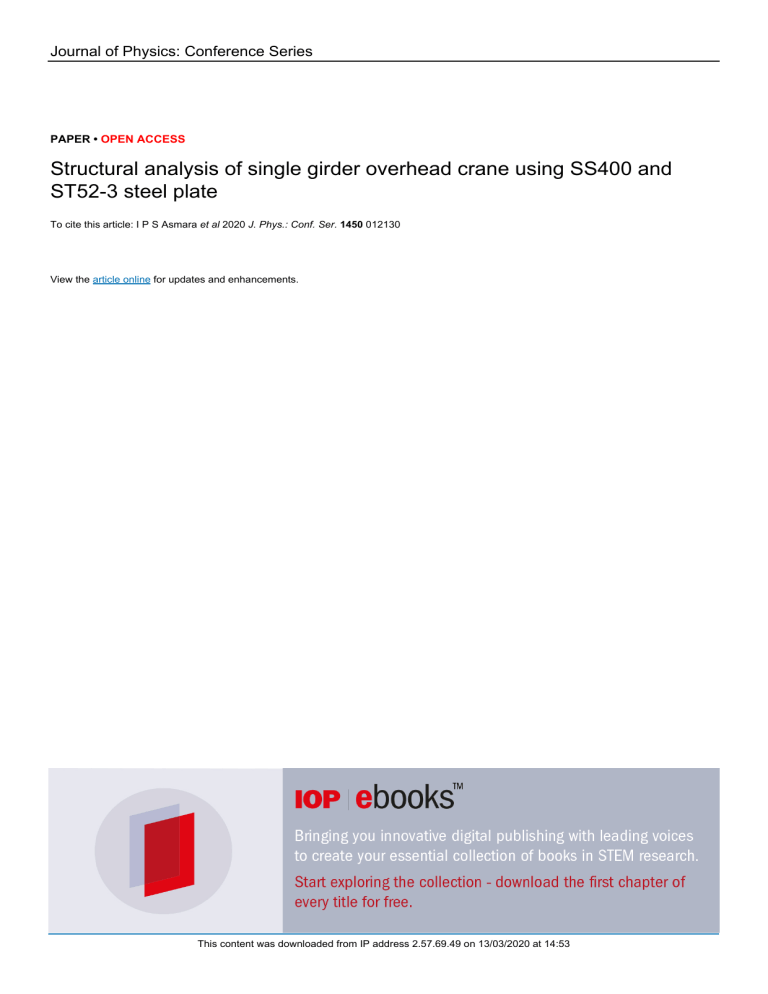
Journal of Physics: Conference Series PAPER • OPEN ACCESS Structural analysis of single girder overhead crane using SS400 and ST52-3 steel plate To cite this article: I P S Asmara et al 2020 J. Phys.: Conf. Ser. 1450 012130 View the article online for updates and enhancements. This content was downloaded from IP address 2.57.69.49 on 13/03/2020 at 14:53 iCAST-ES 2019 Journal of Physics: Conference Series 1450 (2020) 012130 IOP Publishing doi:10.1088/1742-6596/1450/1/012130 Structural analysis of single girder overhead crane using SS400 and ST52-3 steel plate I P S Asmara1, F Hamzah1, L F Susanti1 1 Shipbuilding Engineering Department, Politeknik Perkapalan Negeri Surabaya, Jalan Teknik Kimia, Surabaya, Indonesia E-mail: putusindhu@ppns.ac.id Abstract. This paper is aimed to review the structure of single girder overhead crane using finite element analysis (FEA) technique. The strength and stiffness of existing single girder overhead crane with the capacity of 10 tons SWL and a span of 14 meters are calculated. The existing structure using SS400 steel plates is evaluated and compared with a new design using ST52-3. The stress and deformation of the existing structure are analyzed using Ansys software and a new design is proposed. Further, the effect of girder weight reduction to the decreasing of power required by the long-traveling motor is identified. The analysis shows the reduction of structure mass on the new design is 0.8 tons and the decrease in required traveling power is 1 kW. The maximum stresses of the existing and the new structure are 25 percent and 23 percent of the yield strength of the SS400 and ST52-3. The percentages of the maximum deformation to the allowable deflection limit are 43 percent and 58 percent, respectively. 1. Introduction Overhead crane structure consists of two-part, mainly girder and end carriage, as shown by part number 1 and 2, respectively in Figure1. The main structure of an overhead crane is the girder. The type of girder mainly depends on the capacity and span. A girder with the capacity of 20 tons SWL and a span of 20 meters is designed using the double girder [1]. A hoist is attached on the top of the double girder performing the hoisting and traveling of the load, transversely. In this study, the capacity of the crane is 10 tons SWL and the type of the girder is single as shown in Figure 1. The hoist is attached on the bottom plate of the single girder. The crane having the capacity of more than 5 tons and the span of more than 12 meters usually using the structure of the box. A girder with the capacity of less than 5 tons SWL and the span of less than 12 meters usually designed using a simple structure of the “I” Section. Optimization of the girder will provide a reduction in the weight of the crane. The cost of the material handling equipment depends on the weight of the material. Optimization of the girder with the capacity of 75 tons and 21 meters span contributed to the value of the weight of 2.5 tons [2]. In this study, the reduction of girder weight is investigated and a new design is proposed using other specifications of material. The existing girder using the material of SS400 which has the yield strength of 235MPa is replaced by the material of ST52-3 having the yield strength of 355 MPa. The usage of higher material strength is intended to reduce the weight of the girder with the same safety factor. The reduction in the weight of the girder will decrease the power of longitudinal traveling motor which is one of the main components of the crane. The lower the power will decrease the price and operational cost of the crane. Content from this work may be used under the terms of the Creative Commons Attribution 3.0 licence. Any further distribution of this work must maintain attribution to the author(s) and the title of the work, journal citation and DOI. Published under licence by IOP Publishing Ltd 1 iCAST-ES 2019 Journal of Physics: Conference Series IOP Publishing doi:10.1088/1742-6596/1450/1/012130 1450 (2020) 012130 The capacity of overhead crane is determined by the capacity of the hoist. The capacity of a crane is defined as safe working load (SWL), the maximum mass, in tons, which may be lifted vertically by a lifting appliance at the hanging point of the load (hook or lifting ring). Another form of capacity is safety working force (SWF), the static force, in kN, corresponding to the SWL [3]. Both ends of the girder are fitted fixedly at the web plates of two end carriages. End carriages equipped with a pair of synchronized long traveling motors and wheels to move the crane, longitudinally. The required power of the motor depends on the capacity of the crane and affected by the weight of the hoist and the structure. The weight of the structure is minimized by considering the criteria of allowable stress and deflection. The strength criterion for a crane is the allowable stress of the structure of less than the safety factor multiplied by the yield strength of the material as shown by Equation (1) [3]. Permitted deflection of the girder is defined in Equation (3) [2]. 𝜎𝑎𝑙𝑙 ≤ η𝑅𝑒 (1) 𝜎 = √(𝜎𝑡 + 𝜎𝑓 )2 + 3𝜏 2 (2) 𝛿𝑎𝑙𝑙 = 𝐿⁄600 (3) Where, σ_(t) is normal tensile stress, σ_(f) is normal bending stress due to bending moment, τ is total tangential shear stress, η is safety factor, 0.5 for overhead crane [3] and R_e is yield strength, and L is span. Figure 1. Typical structure of overhead crane. 2. Methods The dimension of the existing single girder to be evaluated is shown is Table.1 The detail dimension of the girder is shown by the cross section in Figure 2 and Table 2. The main dimension of the box girder is 900 mm height and 200 widths. The girder is constructed using material of SS400 having the yield strength of 235 MPa. Table 1. The existing crane specification. No 1 2 3 4 5 6 Specification Capacity, SWL Span Hoisting speed Cross traveling speed Long traveling speed Box girder 2 Dimension 10 tons 14 m 4 m/min 7 m/min 7 m/min 900×200 mm iCAST-ES 2019 Journal of Physics: Conference Series 1450 (2020) 012130 IOP Publishing doi:10.1088/1742-6596/1450/1/012130 Figure 2. Cross section of single girder. Table 2. Detail dimension of the existing girder. Variable B1 B2 B3 B4 B5 B6 B7 B8 B9 B10 B11 B12 Dimension 400 mm 300 mm 6 mm 6 mm 60 mm 6 mm 6 mm 60 mm 40 mm 36 mm 36 mm 60 mm Variable H1 H2 H3 H4 H5 H6 H7 H8 H9 H10 H11 H5 Dimension 12 mm 863 mm 863 mm 20 mm 6 mm 54 mm 54 mm 6 mm 4 mm 4 mm 4 mm 6 mm The allowable stress and deflection of the girder using the SS400 and ST52-3 steel plates are shown in Table 3. Firstly, the stress and deflection of girder and carriage are calculated analytically, using Equation (4) to Equation (9) according to the bending moment theory based on the simple and fixed supported beam [4]. Secondly, the stress is compared to the maximum von-mises stress based on the computation of the finite element method (FEM) using Ansys Software. A study on the effect of the number of elements to the von-mises stress in beam analysis using Ansys found high sensitivity. A change in the number of elements in a small number increases the stress by up to 48%. However, the effect to the deflection is less sensitive. The percentage error of deflection to the analytical calculation is up to 4% [5]. 𝑀= 𝑀= 𝑃𝐿 4 + 𝑃𝐿 8 𝑞 𝐿2 8 + : for simple support 𝑞 𝐿2 12 : for fixed support 𝑐 𝑀 𝐼 𝑆 𝜎𝑓 = 𝑀 = 3 (4) (5) (6) iCAST-ES 2019 Journal of Physics: Conference Series 1450 (2020) 012130 𝜏= 𝛿 = 𝛿 = 𝐿3 𝑃 48 𝐸 𝐼 𝑃 𝐿3 + 192 𝐸 𝐼 + 𝐿4 IOP Publishing doi:10.1088/1742-6596/1450/1/012130 𝑉𝑄 𝐼𝑡 5𝑞 384 𝐸 𝐼 𝑞 𝐿4 (7) : for simple support (8) : for fixed support (9) 384 𝐸 𝐼 Where, M is bending moment (N.mm), 𝜎 is the maximum stress (MPa), 𝜏 is shear stress, 𝛿 = the maximum deflection, L is span (mm), P is the single centered load (N), q is uniformly distributed load (N/mm), I is the moment of inertia of cross section (mm4), c is the maximum distance to the neutral axis (mm), S is sectional modulus (mm3), V is shear force, Q is statically moment, t is plate thickness, and E is modulus of elasticity (N/mm2). Table 3. Allowable stress and deflection. Materials SS400, Yield Strength = 235 MPa ST52-3, Yield Strength = 355 MPa Allowable Stress (MPa) ≤ 117.5 Allowable Deflection of Girder (mm) ≤ 23.33 ≤ 177.5 ≤ 23.33 3. Results and discussion The mass of existing girder and end carriage are 3.18 and 0.56 tons, respectively. The distance of the neutral axis to the surface of the bottom plate is 420 mm for the girder and 175 mm for the end carriage. The moment of inertia and sectional modulus of the girder and end carriage are presented in Table 4. The table shows that the criteria for stress need sectional modulus higher than the criteria of deflection. The ratio of required modulus to the actual modulus of the girder is only 25% indicated that the existing single girder is over design. The modulus ratio of the end carriage is 77.5%. It is more efficient than that of the girder. Table 4. Moment of inertia and sectional modulus. Criteria Momen of Inertia (mm4) Actual Required The Stress of Single Girder [3,5] Sectional Modulus (mm3) Actual Required ≥ 7.99×108 3.23×109 ≥ 1.90×106 7.69×106 The Deflection of Single Girder [2,5] ≥ 1.32×x108 ≥ 7.55×105 The Stress of End Carriage [3,5] ≥ 2.13×108 ≥ 1.22×106 2.75×108 The Deflection of End Carriage [2,5] 1.57 ×106 ≥ 3.18×106 ≥ 1.82×104 The meshing of the girder model is developed using the hex-dominant method. The fixed support is applied at the end cover plate of the girder. Centered load of the SWL and hoist mass is applied at both side on the bottom plate of the middle part of the girder, and the weight of the girder is uniformly distributed on the top plate as shown in Figure 4 and 5, respectively. 4 iCAST-ES 2019 Journal of Physics: Conference Series 1450 (2020) 012130 IOP Publishing doi:10.1088/1742-6596/1450/1/012130 Figure 3. Centered loads. Figure 4. Uniform distributed load. Figure 5. Cylinder support at the wheel axle holes. 5 iCAST-ES 2019 Journal of Physics: Conference Series 1450 (2020) 012130 IOP Publishing doi:10.1088/1742-6596/1450/1/012130 Figure 6. Girder stress analysis. Figure 7. Girder deflection analysis. The cylinder support at the wheel axle is applied as presented in Figure 6. The von-mises stress and deflection analysis of the girder is shown by Figure 7 dan 8, respectively. The stress and deflection of the existing structure based on the FEM analysis as shown in table 5 indicate that the structure is overdesigned having the η of 0.25 or the safety factor of 4 based on the yield strength. Based on the criterion of deflection, the actual deflection will be only 43% of the allowable deflection limit. Amreeta and Singh [6] recommended a structure of single girder jib crane with stress of 289.57 MPa and the η of 0.82 or the safety factor of 1.2. The structure is safe according to I.S norms IS 807:2006 Design, Erection and Testing - Structural Portion of Cranes and Hoists and IS 15419:2004 Jib Cranes - Code of Practice [6]. Abid, Akmal, and Wajid [7] proposed an optimum structure of the box-type girder of an overhead crane with the maximum stress of 157 MPa. The structure has the η of 0.67 which is the safety factor of 1.5 based on the yield strength of 235 MPa. Table 5. Stress and deflection of existing girder. Stress (MPa) Deflection (mm) Allowable Stress 117.5 23.33 Analytical 59.64 10.75 6 FEM Analysis 59.60 10.09 iCAST-ES 2019 Journal of Physics: Conference Series 1450 (2020) 012130 IOP Publishing doi:10.1088/1742-6596/1450/1/012130 Redesign of the girder si carried out by decreasing the width of the top plate from 500 to 400 mm and web plate from 863 to 718 mm, as presented by Table 6. The new dimension is calculated by considering the calculation of required moment inertia using Equation (4) to Equation (9). The girder weight becomes 2.37 tons and the moment of inertia becomes 2.09 ×109 mm4 and the distance of neutral axis from the base line is 376 m. The stress and deflection of the new design using FEM analysis and analytical calculation are shown in Figure 9 and 10, and Table 7. Table 6. Detail dimension of the new girder. Variable B1 B2 B3 B4 B5 B6 B7 B8 B9 B10 B11 B12 Dimension 400 mm 8 mm 8 mm 300 mm 60 mm 6 mm 6 mm 60 mm 40 mm 36 mm 36 mm 60 mm Variable H1 H2 H3 H4 H5 H6 H7 H8 H9 H10 H11 H5 Figure 8. Stress of new girder. 7 Dimension 12 mm 718 mm 718 mm 20 mm 6 mm 54 mm 54 mm 6 mm 4 mm 4 mm 4 mm 4 mm iCAST-ES 2019 Journal of Physics: Conference Series 1450 (2020) 012130 IOP Publishing doi:10.1088/1742-6596/1450/1/012130 Figure 9. Deflection of new girder. The results using analytical calculation are higher than those based on the FEM analysis, as seen in Table 7. The differences are 3.48% for stress and 13.12% for the deflection. The actual stress is 23% of the yield strength which represents the safety factor of the structure. The actual deflection is 58% of the allowable deflection limit. The new design decreases the weight of the structure by 25% and resulting the power efficiency of travelling motor by about 1 kW as presented in Table 8. Table 7. Stress and deflection of new girder. Stress (MPa) Deflection (mm) Allowable Stress 177.5 23.33 Analytical 78.69 16.84 FEM Analysis 78.30 13.42 Table 8. Comparison of existing and new girder. Variable Girder height Material Yield Strength Tensile Strength Safety Factor (η maximum is 0.5) Weight Travelling Power Existing Girder 900 mm SS400 235 MPa 400 MPa 0.25 (accepted) 3.18 tons New Girder 800 mm ST52-3 355 MPa 510 MPa 0.23 (accepted) 2.55 tons 23.64 kW 22.83 kW 4. Conclusions The existing structure of the girder using SS400 is over design. The stress is 25% of the yield strength and the deflection is 43% of the deflection limit. The usage of the new design using ST52-3 with the same rate of stress to the yield strength will decrease the weight of structure by 25%. The new design will increase the deflection up to 58% of the limit. The new design decrease the power of the long travelling motor by 1 kW. 5. References [1] Siva S, Chaiyoot M, Suppachai C and Pravit T 2018 International Conference on Metal material Process and Manufacturing (ICMMPM) 207 1-5 8 iCAST-ES 2019 Journal of Physics: Conference Series [2] [3] [4] [5] [6] [7] 1450 (2020) 012130 IOP Publishing doi:10.1088/1742-6596/1450/1/012130 Pratik R P, Bhargav J P and Vipul K P 2014 International Journal of Advance Engineering and Research Development (IJAERD) 1 1-10 Bureau V 2017 Rule for the Certification of Lifting Appliances on board Ships and Offshore Units (France: Bureau Veritas) p 45 Egor P P 1990 Pure Bendign and Bending with Axial Forces (Ney Jersey: Prentice Hall – Englewood Cliffs) pp 280-297 Victor D and Bikramjit D 2014 International Journal of Mechanical Engineering and Technology (IJMET) 5 70-79 Amreeta RK and Singh V 2015 International Journal of Engineering Research and Technology (IJRT) 4 932-936 Abid M, Akmal M H and Wajid H A 2015 IJST Transaction of Mechanical Engineering 39 101112 9

